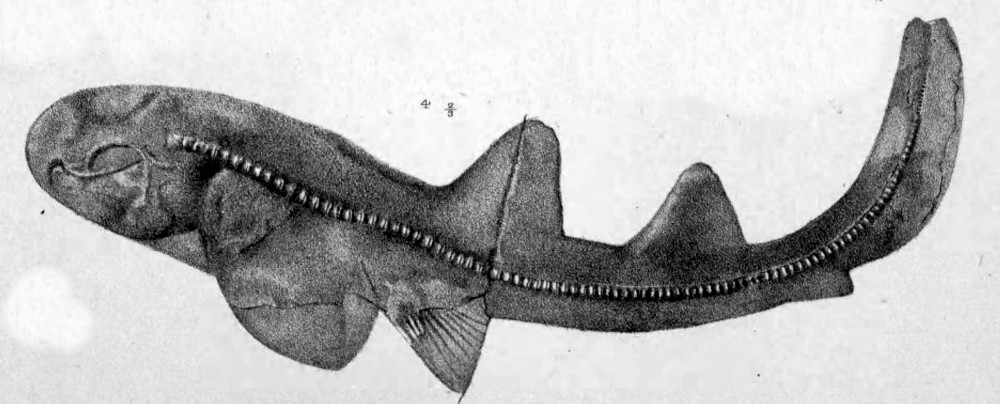Palaeoscyllium minus
Woodward, 1889
Classification: Elasmobranchii Carcharhiniformes Scyliorhinidae
Reference of the original description
Catalogue of the fossil fishes in the British Museum. Part. I. British Museum (Natural History): 474 p., fig., 17 pl.
Catalogue of the fossil fishes in the British Museum. Part. I. British Museum (Natural History): 474 p., fig., 17 pl.
Description:
Citation: Palaeoscyllium minus Woodward, 1889: In: Database of fossil elasmobranch teeth www.shark-references.com, World Wide Web electronic publication, Version 12/2025
Please send your images of "Palaeoscyllium minus" to info@shark-references.com

Palaeoscyllium minus sp. nov.; lateral aspect of fish, two thirds nat. size, L. Kimineridgian; Eichstädt, Bavaria [P 5541]

Palaeoscyllium minus sp. nov.; lateral aspect of fish, two thirds nat. size, L. Kimineridgian; Eichstädt, Bavaria [P 5541]
Description
Original description of Woodward, 1889 [2593]
Type. Nearly complete fish; British Mu-seum. Pectoral fins relatively large. Origin of pelvic fins in advance of the first dorsal; anal completely behind the second dorsal.
Form. & Loc. Lower Kimmeridgian (Lithographic Stone): Bavaria.
P. 5541. Type specimen, figured, of two thirds the natural size, in PI. XVI. fig. 4; Eichstädt. The fish is almost complete, though in some parts indistinctly pre-served. The snout appears to be very obtuse, and the cranial cartilage, so far as observable, presents no features worthy of note. No teeth can be distinguished, and the cartilages of the jaws are crushed and fragmentary. The vertebral column is almost complete and consists of about 100 centra. Of the paired fins, the pectorals appear to have been very large, the length equalling that of the head; and the pelvic fins also attain to considerable proportions, one be-ing well shown and exhibiting several stout cartilaginous rays. When pressed to the side of the trunk the pectorals extend to the base of the pelvic fins; and opposite a point immediately behind the origin of the latter the first dorsal arises. The dorsal fins are nearly equal in size, triangular in form, and separated by an interval only half as long as the base-line of either. The anal, so far as preserved, is extremely small, and placed completely behind the second dorsal; and the caudal fin immediately follows, with an indication of an inferiorly notched extremity. The body is covered with fine dense shagreen, the granules being mostly quadrate, with rounded angles, but sometimes distinctly spinous.
Original description of Woodward, 1889 [2593]
Type. Nearly complete fish; British Mu-seum. Pectoral fins relatively large. Origin of pelvic fins in advance of the first dorsal; anal completely behind the second dorsal.
Form. & Loc. Lower Kimmeridgian (Lithographic Stone): Bavaria.
P. 5541. Type specimen, figured, of two thirds the natural size, in PI. XVI. fig. 4; Eichstädt. The fish is almost complete, though in some parts indistinctly pre-served. The snout appears to be very obtuse, and the cranial cartilage, so far as observable, presents no features worthy of note. No teeth can be distinguished, and the cartilages of the jaws are crushed and fragmentary. The vertebral column is almost complete and consists of about 100 centra. Of the paired fins, the pectorals appear to have been very large, the length equalling that of the head; and the pelvic fins also attain to considerable proportions, one be-ing well shown and exhibiting several stout cartilaginous rays. When pressed to the side of the trunk the pectorals extend to the base of the pelvic fins; and opposite a point immediately behind the origin of the latter the first dorsal arises. The dorsal fins are nearly equal in size, triangular in form, and separated by an interval only half as long as the base-line of either. The anal, so far as preserved, is extremely small, and placed completely behind the second dorsal; and the caudal fin immediately follows, with an indication of an inferiorly notched extremity. The body is covered with fine dense shagreen, the granules being mostly quadrate, with rounded angles, but sometimes distinctly spinous.
References

Catalogue of the fossil fishes in the British Museum. Part. I. British Museum (Natural History): 474 p., fig., 17 pl.

Catalogue of the fossil fishes in the British Museum. Part. I. British Museum (Natural History): 474 p., fig., 17 pl.
















